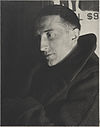| Revision as of 00:51, 19 October 2013 edit65.29.239.115 (talk) Undid revision 577720699 by 108.176.124.84 (talk)← Previous edit | Revision as of 01:22, 19 October 2013 edit undoFlyer22 Frozen (talk | contribs)365,630 editsm Reverted 1 edit by 65.29.239.115 identified as test/vandalism using STikiNext edit → | ||
| Line 5: | Line 5: | ||
| ==Overview== | ==Overview== | ||
| The name of the piece, ''L.H.O.O.Q.'' (in French ''èl ache o o qu''), is a ], since the letters when pronounced in French form the sentence "''Elle |
The name of the piece, ''L.H.O.O.Q.'' (in French ''èl ache o o qu''), is a ], since the letters when pronounced in French form the sentence "''Elle est jolie'", which can be roughly translated as "She is hot", or more accurately "She is pretty".<ref name="Seekamp">{{cite web | first=Seekamp | last=Kristina | title=L.H.O.O.Q. or Mona Lisa | url=http://arthist.binghamton.edu/duchamp/LHOOQ.html | work= | publisher=Binghamton University Department of Art History | year=2004 | archiveurl=http://web.archive.org/web/20060912065248/http://arthist.binghamton.edu/duchamp/LHOOQ.html | archivedate=2006-09-12}}</ref> | ||
| As was the case with a number of his readymades, Duchamp made multiple versions of ''L.H.O.O.Q.'' of differing sizes and in different media throughout his career, one of which, an unmodified black and white reproduction of the '']'' mounted on card, is called ''L.H.O.O.Q. Shaved''. The masculinized female introduces the theme of gender reversal, which was popular with Duchamp, who adopted his own female pseudonym, ], pronounced "Eros, c'est la vie" ("Eros, that's life").<ref> ], Pasadena.</ref> | As was the case with a number of his readymades, Duchamp made multiple versions of ''L.H.O.O.Q.'' of differing sizes and in different media throughout his career, one of which, an unmodified black and white reproduction of the '']'' mounted on card, is called ''L.H.O.O.Q. Shaved''. The masculinized female introduces the theme of gender reversal, which was popular with Duchamp, who adopted his own female pseudonym, ], pronounced "Eros, c'est la vie" ("Eros, that's life").<ref> ], Pasadena.</ref> | ||
Revision as of 01:22, 19 October 2013
"Lhooq" redirects here. For the musical production alias derived from the rectified readymade, see Jóhann Jóhannsson.

L.H.O.O.Q. (Template:IPA-fr) is a work of art by Marcel Duchamp first conceived in 1919. The work is one of what Duchamp referred to as readymades, or more specifically an assisted ready-made. Pioneered by him, the readymade involves taking mundane, often utilitarian objects not generally considered to be art and transforming them, by adding to them, changing them, or (as in the case of his most famous work Fountain) simply renaming them and placing them in a gallery setting. In L.H.O.O.Q. the objet trouvé ("found object") is a cheap postcard reproduction of Leonardo da Vinci's Mona Lisa onto which Duchamp drew a moustache and beard in pencil and appended the title.
Overview
The name of the piece, L.H.O.O.Q. (in French èl ache o o qu), is a pun, since the letters when pronounced in French form the sentence "Elle est jolie'", which can be roughly translated as "She is hot", or more accurately "She is pretty".
As was the case with a number of his readymades, Duchamp made multiple versions of L.H.O.O.Q. of differing sizes and in different media throughout his career, one of which, an unmodified black and white reproduction of the Mona Lisa mounted on card, is called L.H.O.O.Q. Shaved. The masculinized female introduces the theme of gender reversal, which was popular with Duchamp, who adopted his own female pseudonym, Rrose Sélavy, pronounced "Eros, c'est la vie" ("Eros, that's life").
Primary responses to L.H.O.O.Q. interpreted its meaning as being an attack on the iconic Mona Lisa and traditional art, thus promoting the Dadaist ideals.
According to Rhonda R. Shearer, the apparent reproduction is in fact a copy partly modelled on Duchamp's own face.
Versions
- 1919 – Private collection, Paris, on loan to the Musée National d'Art Moderne, Centre Georges Pompidou, Paris.
- 1920 – Present location unknown.
- 1930 – Large scale replica, private collection, Paris
- 1940 – A color reproduction made from the original. It was stolen in 1981 and has not been recovered.
- 1958 – Collection of Antoni Tapies, Barcelona.
- 1960 – Oil on wood. In the collection of Dorothea Tanning, New York.
- 1964 – Thirty-eight replicas made to be inserted into a limited edition of Pierre de Massot's Marcel Duchamp, propos et souvenirs. Collection of Arturo Schwarz, Milan.
- 1965 – L.H.O.O.Q. Shaved is a playing card reproduction of the Mona Lisa mounted on paper. The Mona Lisa painting is unmodified but for the inscription LHOOQ rasée.
See also
References
- Kristina, Seekamp (2004). "L.H.O.O.Q. or Mona Lisa". Unmaking the Museum: Marcel Duchamp's Readymades in Context. Binghamton University Department of Art History. Archived from the original on 12 September 2006.
{{cite web}}: External link in|work= - Marcel Duchamp, L.H.O.O.Q. or La Joconde, 1964 (replica of 1919 original) Norton Simon Museum, Pasadena.
- Marting, Marco De (2003). "Mona Lisa: Who is Hidden Behind the Woman with the Mustache?". Art Science Research Laboratory. Retrieved 27 April 2008.
External links
| Appropriation in the arts | |||||||||||||||
|---|---|---|---|---|---|---|---|---|---|---|---|---|---|---|---|
| By field |
| ||||||||||||||
| General concepts |
| ||||||||||||||
| Related artistic concepts | |||||||||||||||
| Standard blocks and forms | |||||||||||||||
| Epoch-marking works |
| ||||||||||||||
| Theorization | |||||||||||||||
| Related non- artistic concepts | |||||||||||||||
| Marcel Duchamp | ||
|---|---|---|
| Artworks |
|  |
| Films |
| |
| Related | ||
Categories: